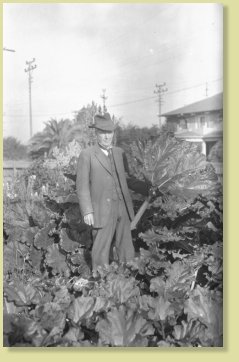 |
Robbins-Mills Collection of Herbert Wendell Gleason Photographic Negatives, 1899-1937 Concord Free Public Library — Special Collections |
Series XI – Luther Burbank, 1909-1923
 Series XI (165 glass, 102 film; arranged by date). Luther Burbank, horticulturalist (1849-1926), introduced more than 800 new varieties of fruits, flowers, vegetables, and grains using hybridization and selection. The series contains over 200 images including, portraits of Luther Burbank, his home in Santa Rosa, CA, his experimental farm in Sebastopol, CA, horticultural experiments, and the surrounding area. Among the portraits of Luther Burbank are photographs of Burbank with several of his plant-breeding experiments including cherries, a chestnut tree, and a stalk of giant rhubarb. Other images of Luther Burbank include Burbank and friends picking cherries, and Burbank sitting in front of his home in Santa Rosa.
Series XI (165 glass, 102 film; arranged by date). Luther Burbank, horticulturalist (1849-1926), introduced more than 800 new varieties of fruits, flowers, vegetables, and grains using hybridization and selection. The series contains over 200 images including, portraits of Luther Burbank, his home in Santa Rosa, CA, his experimental farm in Sebastopol, CA, horticultural experiments, and the surrounding area. Among the portraits of Luther Burbank are photographs of Burbank with several of his plant-breeding experiments including cherries, a chestnut tree, and a stalk of giant rhubarb. Other images of Luther Burbank include Burbank and friends picking cherries, and Burbank sitting in front of his home in Santa Rosa.
Images of fruits include apples, blueberries, cherries, nectarines, peaches, plums, quince, and seedless grapes. Flower varieties include amaryllis, hybrid dahlias, "firecracker" flower, gladiolus, larkspur, marigolds, hybrid petunias, Shasta Daisy (named for Mt. Shasta), Shirley Poppies, and hybrid sunflowers. Vegetables include kale, onions, the Burbank potato (ancestor of the Idaho potato), giant red peppers, and tomatoes. Grains include varieties of corn hybrids from teosinte (believed to be the wild progenitor of modern corn), and macaroni wheat. Novelties include plumcots, spineless cactus, and thornless blackberry.
Other subjects in the series include: Armstrong Redwood Grove, the remnant of an old-growth redwood forest and botanical park established by Colonel James Armstrong in the 1880s; a local church built from a single redwood tree (both interior and exterior scenes); the Luther Burbank School in Santa Rosa; views along the Russian River; and a Sonoma Valley vineyard.